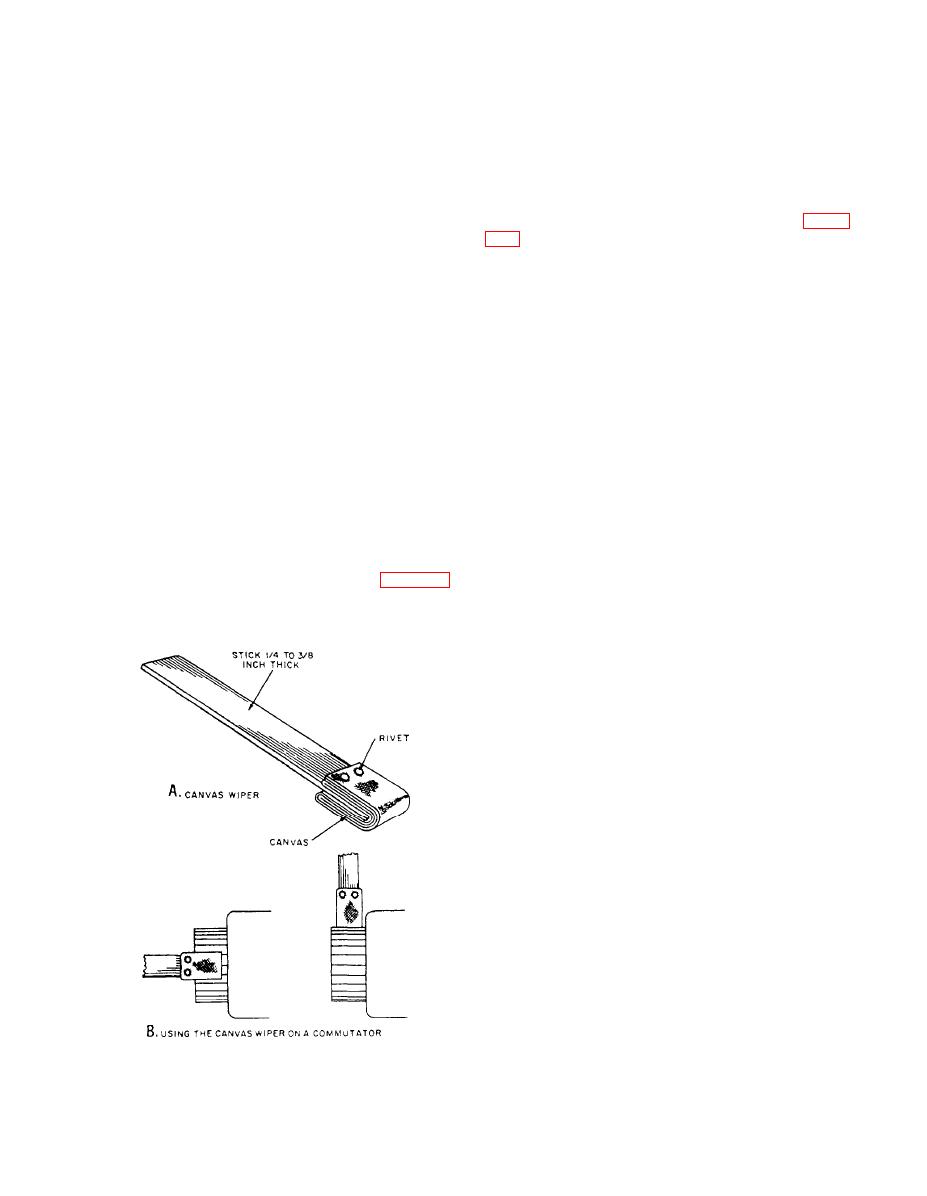 |
|||
|
Page Title:
Figure 3-13.--Cleaning commutator or collector rings. |
|
||
| ||||||||||
|
|
 view A). Secure the canvas with rivets, and wrap linen
Use a vacuum cleaner during the seating operation
tape over the rivets to prevent the possibility of them
to prevent dust from reaching the machine, the
coming in contact with the commutator. When the
machine windings, and the bearings. After seating all
outer layer of canvas becomes worn or dirty, remove
the brushes, blow out the machine with a power blower
it to expose a clean layer. The wiper is most effective
or completely dry compressed air, or clean thoroughly
when it is used frequently. On ship's service
with a vacuum cleaner.
generators, it may be desirable to use the wiper once
For additional information on brushes, brush
each watch. When using the wiper, exercise care to
problems, and probable causes, refer to NSTM, chapter
keep from fouling moving parts of the machine. Figure
300.
to a commutator.
Commutator Care
When the machines are secured, you can use a
toothbrush to clean out the commutator slots. You can
After being used about 2 weeks, the commutator
use a clean canvas or lint-free cloth for wiping the
of a machine should develop a uniform, glazed, dark
commutator and adjacent parts. Besides cleaning by
brown color on the places where the brushes ride. If a
wiping, periodically clean the commutator with a
nonuniform or bluish-colored surface appears,
vacuum cleaner or blow it out with clean, dry air.
improper commutation conditions are indicated.
Do not sandpaper a commutator if it is operating
Periodic inspections and proper cleaning practices
well, even if long service has developed threading,
will keep commutator and collector-ring troubles to a
grooving, pits, bum areas between bars, longitudinal
minimum.
irregularities, and so on, unless sparking is occurring
One of the most effective ways of cleaning the
or the brushes are wearing excessively. In sanding a
commutator or collector rings is to apply a canvas
commutator, use a fine grade of sandpaper (No. 0000
wiper while the machine is running. You can make the
is preferred, but in no case coarser than No. 00). You
wiper by wrapping several layers of closely woven
can use sandpapering to make emergency reduction of
canvas over the end of a strong stick between
high mica or to polish finish a commutator that has
one-fourth and three-eighths inch thick (fig. 3-13,
been stoned or turned. Attach the sandpaper to a
wooden block shaped to fit the curvature of the
commutator, and move the block slowly back and
forth across the surface of the commutator while the
machine is running at moderate speed. Rapid
movement or the use of coarse sandpaper will cause
scratches. Never use emery cloth, emery paper, or
emery stone on a commutator or collector ring since
the danger of causing electrical shorts exists.
Additional information on the care and cleaning
of the commutator can be found in NSTM, chapter 300,
"Electric Plant General."
Bearings
Bearings are designed to allow a rotating armature
or rotor to turn freely within a motor or generator
housing. The two common types of bearings found in
motors and generators are antifriction bearings and
friction bearings.
ANTIFRICTION BEARINGS.-- There are two
types of antifriction bearings--ball and roller.
Basically, both types consist of two hardened steel
rings, hardened steel rollers or balls, and separators.
The annular, ring-shaped ball bearing is the type of
|
|
Privacy Statement - Press Release - Copyright Information. - Contact Us |